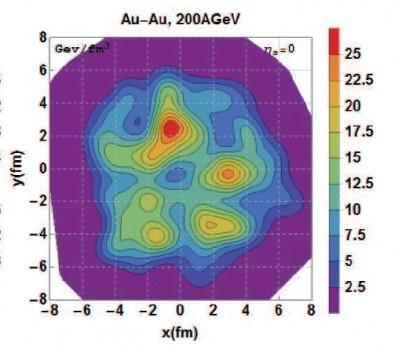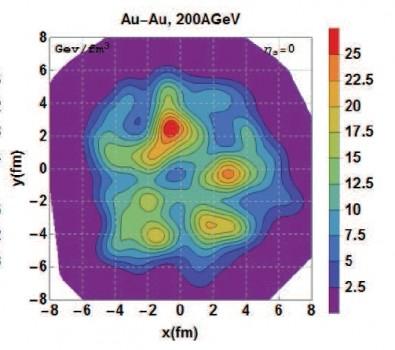
Credit: Researcher's archive
Quark-gluon plasmas are among the subjects that have been most extensively researched by physicists in recent times. Thanks to the largest particle accelerators in operation today – the Large Hadron Collider (LHC) in Europe and the Relativistic Heavy Ion Collider (RHIC) in the United States – it is now possible to reproduce a quark-gluon plasma in the laboratory. This state of matter is believed to have predominated in the universe for a fraction of a second after the Big Bang.
According to the standard cosmological model, the duration of the quark-gluon plasma in the primordial universe was no more than one millionth of a second, since the universe is thought to have cooled approximately 10-6 s after the Big Bang to the extent that quarks and gluons could no longer move freely and instead became confined in hadrons (protons, neutrons, mesons, etc.). In the high-energy nuclear collisions produced at the LHC and RHIC, the quark-gluon plasmas last for an even shorter time – approximately 10-23 s – because of steep pressure gradients. Despite their transience and tiny volume (the diameter of a proton is on the order of 10-15 m), quark-gluon plasmas conceal intense and complex inner activity.
This activity is gradually being unveiled in LHC and RHIC experiments, and new theoretical approaches have been developed to explain or predict their results. A case in point, among many others, is the study "Hydrodynamic predictions for mixed harmonic correlations in 200 GeV Au+Au collisions", published in Physical Review C and highlighted as an Editors' Suggestion.
The study was performed by Fernando Gardim, from the Science & Technology Institute at the Federal University of Alfenas, Minas Gerais State (Southeast Brazil); Frédérique Grassi and Matthew Luzum, from the Physics Institute at the University of São Paulo (USP); and Jacquelyn Noronha-Hostler, from the Department of Physics at the University of Houston.
"Because of its very short duration, a quark-gluon plasma can't be observed directly," Grassi told. "The experiments are able to detect the hadrons formed when quarks and gluons recombine. These hadrons propagate in several directions. Their angular distribution around the axis of collision supplies highly relevant information about the plasma's structure and dynamics and, consequently, about the nature of the fundamental interactions in matter. Our study, which was theoretical, set out to predict specific patterns in the hadrons' angular distribution."
The researchers used a hydrodynamic model called NeXSPheRIO, which accurately reproduced a broad range of data obtained experimentally at RHIC. The computer simulations performed on this basis enabled the researchers to make predictions that can be tested in new experiments so that the model can be validated or corrected.
"The angular distribution observed in the experiments is decomposed into a sequence known in mathematics as a Fourier series," Grassi explained. "Each term in the series corresponds to a specific feature of the distribution, and the series as a whole tells us how many particles move according to each pattern. The phrase 'mixed harmonic correlations' used in the title is the technical term that names the correlations among different Fourier coefficients.
"If a quark-gluon plasma were strictly homogeneous and had the properties of a gas [if its particles interacted very little], then the resulting flow of hadrons would be isotropic [equal in all directions]. But that's not the case. Actual flows detected experimentally are anisotropic, and the angular distribution exhibits non-null Fourier coefficients, which tells us that the plasma is not homogeneous and that its particles interact strongly."
The distribution coefficients are classified according to their geometric characteristics as elliptic, triangular, quadrangular, pentagonal, etc. The predominant flow is elliptic, because the hadron jet is much stronger in one of the directions orthogonal to the axis of collision. This distribution, which results from the strong interaction between quarks and gluons, indicates that the plasma is not a gas but a liquid. However, it is not just any liquid: the fact that the elliptic flow is not attenuated shows that the viscosity of this liquid is extremely low. In fact, a quark-gluon plasma is the least viscous – or most perfect – liquid ever discovered.
"Previous research had already shown that a quark-gluon plasma is a quasi-perfect liquid. What our study added was a better understanding of the non-homogeneity of the energy distribution inside the plasma," Grassi explained. With its very short duration and minute dimensions, a quark-gluon plasma is highly dynamic. Fluctuations cause its energy density to vary from one region to another. The study offers deeper insight into the link between these dynamics and fluctuations.
"Because NeXSPheRIO has so far agreed well with all observations made to date at RHIC, we believe its predictions can be used as a basis of comparison for new measurements to be made at the US collider," Grassi said. "Any deviation from the predictions will supply valuable non-trivial information, either about the initial phase of the collision that gives rise to the plasma or about the intrinsic properties of the medium."
###
Media Contact
Samuel Antenor
[email protected]
55-113-838-4381
@AgencyFAPESP
http://www.fapesp.br
############
Story Source: Materials provided by Scienmag





